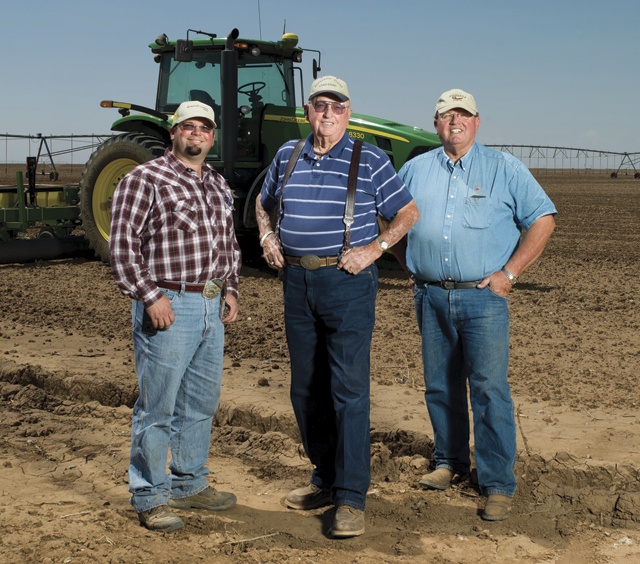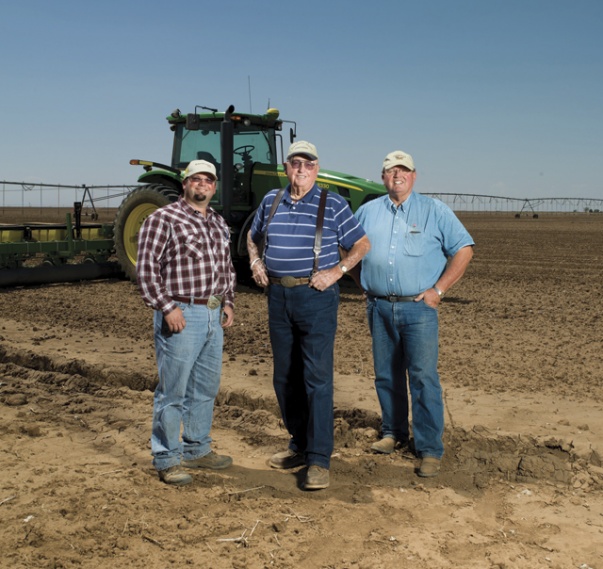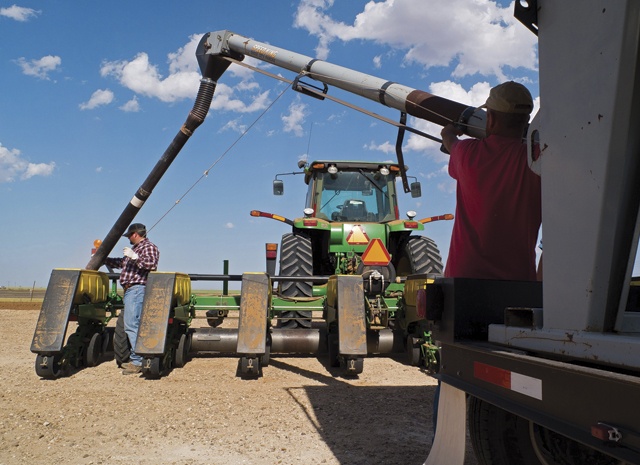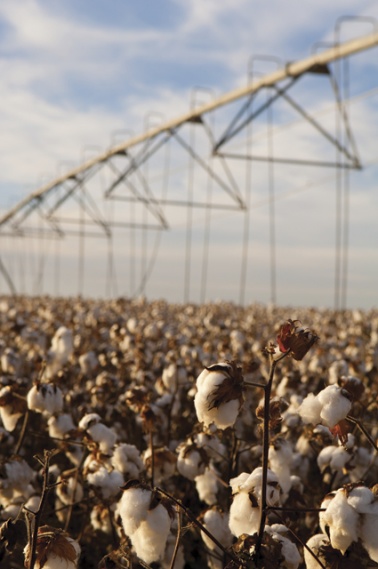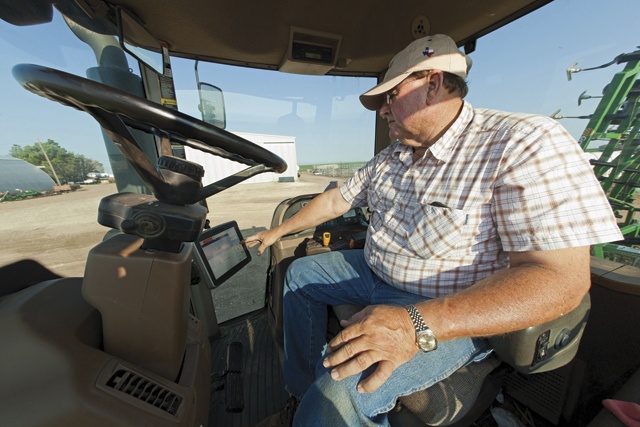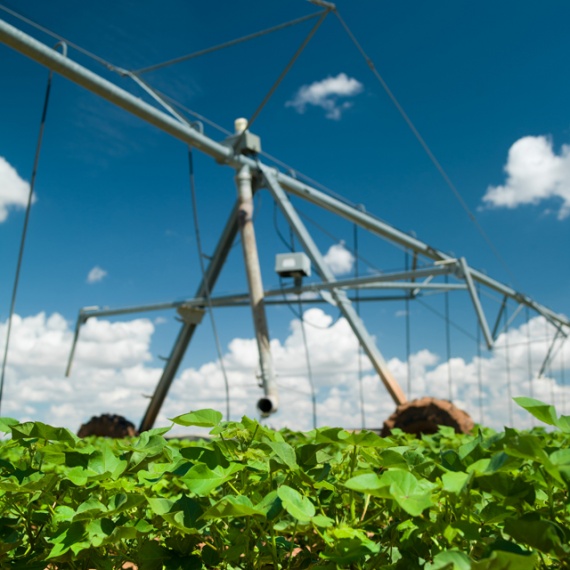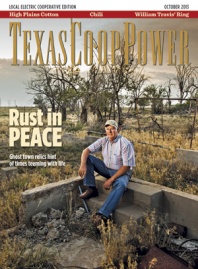After Eddie Smith finished his degree in agricultural economics at Texas Tech University in 1973, he planned to return to graduate school in the fall so he could ultimately become an ag banker. But when he got home to the High Plains that summer, he told his cotton farmer father, Ed, that he’d try farming for a year. “And I had a really good year,” he says wryly, “and here I am now. This is my 40th crop.”
Eddie is steering his pickup down narrow, packed-dirt roads between his fields as he speaks. It’s a sunny, wind-free day in mid-May, and he’s finally able to begin planting his 2,300 irrigated acres outside Floydada, northeast of Lubbock. He also grows dryland cotton on another 600 acres.
He’s a couple of weeks behind schedule because it’s been a cool spring. The last freeze, which normally occurs around April 10, was May 3, and Eddie says you want 10 straight days of temperatures at about 65 degrees to get the ground warm enough for quick and uniform germination. Thanks to the unpredictable weather, including the ongoing drought, growing cotton is not getting easier, says the Lighthouse Electric Cooperative member.
The World’s Largest Cotton Patch
Texas, and especially its High Plains region, is cotton country. Since the late 1800s, Texas has led all states in cotton production nearly every year. The Lone Star State averages about 5.8 million bales annually, grown on about 4.9 million acres—an area more than 12 times as large as the city of Houston. This represents a quarter of the cotton grown in the United States, nearly all of which is exported.
Statewide, cotton is the largest cash crop, pumping more than $1 billion into the economy, second only to the cattle industry in total cash receipts. Though 2011 was the worst year in a long time for Texas cotton producers, 2012 brought an improvement of about 43 percent, still well below predrought numbers. The High Plains region accounts for more than 60 percent of the state’s total cotton output. Its 41 counties, between Midland and the New Mexico state line and to the top of the Panhandle, comprise the largest contiguous cotton patch in the world.
For Eddie, the choice to grow cotton comes down to simple economics. “There’s not much you can do in this region except farm, and the semiarid desert conditions here give us a competitive edge in growing cotton,” he explains. “That’s what we can grow best, so that’s what we grow.”
Planting Time
The day begins around 6:30 a.m. for Eddie and his four employees, including his 36-year-old son, Eric, another Tech grad. They meet in Eddie’s office, an old farmhouse surrounded by flat, still-bare land. Ed, 84, who daily drives the 50 miles between his Lubbock home and the farm, will arrive shortly to run errands and do odd jobs.
Eric begins going over map reports, provided by the John Deere tractor’s GPS system, with Clint Bigham, whom Eddie calls “my computer gun.” Eddie’s been using guidance systems for about 10 years but just upgraded this year to a program that steers farmers through planting and then prints out exactly how much was planted on exactly how many acres.
After they’ve determined today’s agenda, they all go outside to fill the planter boxes. A huge white bag about half the size of a Volkswagen Beetle, filled with a ton of cottonseed, is hoisted by automated lift over a bin. Eric cuts its bottom open with a knife so the seeds spill out. The bin is driven to a tractor with a 28-foot-wide horizontal steel bar holding eight seed boxes. Seeds are loaded down a chute into each of the boxes. The process is repeated with a second tractor, and both vehicles rumble out to the first field.
Farming and Technology
On one side of the field, Clint begins plotting 16 straight rows on the tractor’s GPS while Eric does the same for the circles of crop that will cover the rest of the field. The rows-and-circles system allows the necessary turning area for the sprayer and harvester that will traverse the field.
After establishing a starting point, Clint drives to the other end of the field and establishes a second point. The tractor’s satellite guidance system does the rest, moving in a perfect line between the two points to plant four seeds per foot, each 1 3/4 inches deep, eight rows at a time. The driver needn’t touch the steering wheel—in fact, it’s better if the wheel isn’t touched because it could throw the system out of alignment, bringing planting to a halt while everything is recalibrated.
“Technology’s pretty much where all farming’s headed. You’re always trying to reduce the amount of physical labor and manpower costs you need to do the job,” Eddie declares as he leaves Eric and Clint to plant this field while he makes his other rounds. At one stop, he punches in a code to release water to the center-pivot irrigation system in the adjacent field, which was planted the previous day. The center-pivot is a long network of horizontal pipes on wheels with sprinklers positioned along the entire length.
After waiting about a half-hour for the water to reach the machine’s pivot point and circulate through the pipes, Eddie sets another computerized tool beside the pivot that controls how water is dispersed from the sprinklers onto the crops as the entire machine slowly circles through the field. Throughout the day he crisscrosses his fields, spraying one, watching planting at another, irrigating a third, his cellphone ringing constantly as Eric, Clint and Ed ask questions and give status reports. Work will continue until about 8 p.m., a 13-hour day at minimum. “Even with all the technology, it’s a physical challenge just being out in the sun and around these fields all day,” he says.
But the difference that technology makes is enormous. Because the size, precision and efficiency of machinery grow every year, it’s hard to quantify the improvement in the fields. But Eddie figures that this technology has allowed his production capacity per acre to double, at least, in the past 20 years—and the quality of the cotton is superior as well.
Watching and Waiting
The period between Mother’s Day and Father’s Day is crucial. That’s when Eddie most needs rain but also when High Plains winds are strongest, blowing sand through the fields that can damage the young cotton plants. If they survive that, the plants become more durable. “Extremes are always what hurt you,” Eddie says, “extreme hot or cold, extreme wet or dry.”
At eight to 10 weeks, the cotton flower blooms and spreads pollen to help form the boll, which holds the lint and seeds. The bolls soon open to let in air that dries and fluffs the white fiber. Before the bolls can be harvested, the leaves must be removed from the plants. This is done by using crop dusters to spray the plants with a chemical that causes the leaves to fall off, known as defoliation. Beginning in mid-October and ending ideally by Thanksgiving, the cotton is harvested by machines called strippers and taken to the gin, where the lint is separated from the seed and the fiber is cleaned. The lint is then marketed to textile mills worldwide by the 25,000-member Plains Cotton Cooperative Association, whose board Eddie currently chairs. Cottonseeds can be used to plant a new crop or can be crushed into cottonseed oil, bringing in a small amount of additional revenue.
The Cycle Begins Anew
In the off-season he’ll grow some winter wheat, but like most cotton growers he considers rotating crops to be economically unfeasible. Instead, as the new year begins, he’s prepping his fields for more cotton. This is followed by what he jokingly calls “the season of meetings,” when growers attend trade shows, symposia and conventions, such as the one by the National Cotton Council of America, to learn about new technology, techniques and research.
During January and February, he also refinances with the bank and settles up his other business affairs. In mid-March, he sprays herbicides in the fields to prevent weeds and waters as much as he can afford, which these days is not nearly as much as he’d like. Then Eddie and his crew will start planning crop No. 41.
——————–
John Morthland is an Austin writer.
